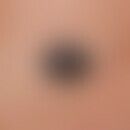HistoryThis section has been translated automatically.
The description and designation of a paradoxical pulsus is first found in 1873 in a manuscript by Adolf Kussmaul: Ueber schwielige mediastino-pericarditis und den paradoxen pulsus.Kussmaul describes the paradoxical pulse as a light and irregular pulse, which disappears during inhalation and reappears during exhalation. However, the first written evidence of the reduction in pulse volume during inspiration was given by Lomer in 1669 in a patient with constructive pericarditis.
DefinitionThis section has been translated automatically.
During inspiration the right ventricle expands due to the increased venous return. As a result, the interventricular septum bulges into the left ventricle and reduces its size (so-called reverse Bernheim effect). The dilated lungs accumulate more blood and the return to the left ventricle is reduced. This in turn causes a reduction in the stroke volume of the left ventricle. In addition, the pressure is transferred to the aorta during inspiration
Due to these mechanisms, a drop in systolic blood pressure occurs during inspiration even in healthy individuals.
In the case of a pulsus paradoxus, however, a pathological drop in systolic blood pressure of more than 10 mmHg occurs during inspiration.
You might also be interested in
EtiologyThis section has been translated automatically.
The following clinical pictures can lead to the occurrence of a pulsus paradoxus:
- restrictive cardiomyopathy
- Pericardial tamponade (most common cause)
- Pericardial effusion
- right ventricular myocardial infarction
- cardiogenic shock
- Pericarditis constrictiva calcarea
- Tension pneumothorax
- Pulmonary embolism
- severe asthmatic attack
- obstructive pulmonary diseases
- anaphylactic shock (during injection of urokinase: Ward G L 1992)
- Obstruction of the superior vena cava
- gastric volvulus
- Diaphragmatic hernia
- extreme obesity
ClinicThis section has been translated automatically.
The pathological drop in systolic blood pressure during inspiration can lead to an increase in jugular vein pressure (so-called kissing mouth sign) with congestion of the jugular vein. This sign is an indication of an epicardial constriction.
In addition, during inspiration there is a marked weakening and even disappearance of the palpable peripheral pulsus. During expiration the pulse should be palpated with normal strength. The auscultation of the heart sounds is inconspicuous during inspiration and expiration.
DiagnosisThis section has been translated automatically.
There are different ways to measure a Pulsus paradoxus, both apparatus and mechanical.
Measurement of Pulsus paradoxus with a blood pressure cuff:
The patient should not breathe too deeply, but already deep enough to detect chest movements.
The blood pressure is then measured and the cuff is pumped approx. 20 mm Hg above the systolic pressure. The cuff is then deflated at a slow rate (approx. 2 - 3 mm Hg per heartbeat) until the Korotkov sound is heard during expiration. Then the pressure at which the Korotkow sound is heard equally well during both exhalation and inspiration is measured. If the difference between the two values exceeds 10 mm Hg, there is a pulsus paradoxus.
Arterial waveform analysis
For the diagnosis of a pulsus paradoxus the available arterial waveform of the monitoring device can be used in the intensive care unit. Changes in systolic blood pressure during inhalation and exhalation are visualized.
Pulse oxymetry waveform analysis
This technique is used, for example, for newborns with cardiac tamponade.
Pulse oximetry waveform analysis is also a useful and non-invasive way of continuously determining the severity of a pulsus paradoxus in patients with obstructive airway disease.
Inverted Pulsus paradoxus
A reverse pulsus paradoxus is the rise in systolic blood pressure during inspiration. This increase in pressure is significant at values above 15 mm Hg.
The phenomenon was first described in 1973 by Massumi RA et al. in patients with idiopathic hypertrophic subaortic stenosis, isorhythmic ventricular rhythm and in patients with left ventricular failure during positive pressure ventilation.
Patients who become mechanical show inward displacement of the ventricular wall during systolic pressure ventilation to support ventricular emptying. This mechanism leads to the slight increase in systolic pressure.
The reverse pulsus paradoxus can be used, among other things, because it is a sensitive indicator of hypovolemia in mechanically ventilated patients.
Pseudopulsus paradoxus
Already in 1924 Gauchat and Katz pointed out in a patient with complete heart block that a pulsus paradoxus can be diagnosed erroneously with certain particularities.
They therefore laid down guidelines that must be strictly adhered to when diagnosing pulsus paradoxus in order to avoid false diagnoses:
- The pulse must be palpated in all accessible arteries.
- There is no need for deep inspiration
- There must be no irregular heart activity
absence of pulsus paradoxus
There are also cases where one would normally expect a pulsus paradoxus, but this cannot be determined. Mostly this is due to the fact that different mechanisms of compensation are used and thus the Pulsus paradoxus is prevented.
This can be the case with the following diseases:
- If an aortic dissection has led to both cardiac tamponade and aortic insufficiency, the left ventricle fills up during inspiration from the aorta. In this case the pulsus paradoxus is missing.
- Major atrial septal defect: In this case the left-right shunt compensates for the normal increase in venous return during inspiration.
- Isolated right ventricular tamponade: May occur in patients with chronic renal insufficiency under dialysis. The absence of the pulsus paradoxus is a characteristic feature here.
- Increased left ventricular diastolic pressure.
- Changes in intrathoracic pressure due to lack of chest wall mobility (e.g. severe rheumatoid spondylitis)
- Coexistent state that produces an inverted pulsus paradoxus.
TherapyThis section has been translated automatically.
Therapeutic measures depend on the underlying disease causing the pulsus paradoxus.
PrognoseThis section has been translated automatically.
The prognosis depends on the underlying disease.
LiteratureThis section has been translated automatically.
- Bilchick K C et al (2002) Paradoxical physical findings described by Kussmaul: pulsus paradoxus and Kussmaul's sign. The Lancet 359: 1940-1942
- Gauchat H, Katz LN (1924) Observations on pulsus paradoxus. Arch Internal Med 33: 371-393
- Herold G et al (2018) Internal Medicine. Herold Publisher SS 236, 362
- Khasnis A et al (2002) Clinical sign in medicie: pulsus paradoxus. Journal of Postgraduate Medicine 48: 46-49
- Kasper D L et al (2015) Harrison's Principles of Internal Medicine. Mc Graw Hill Education SS 1445-1446
- Massumi RA et al (1973) Method and apparatus for measuring pulsus paradoxus. N Eng J Med 289: 1272-1275
- Ward G L et al (1992) Pulsus paradoxus in anaphylactic shock due to urokinase administration. Chest 101: 589




